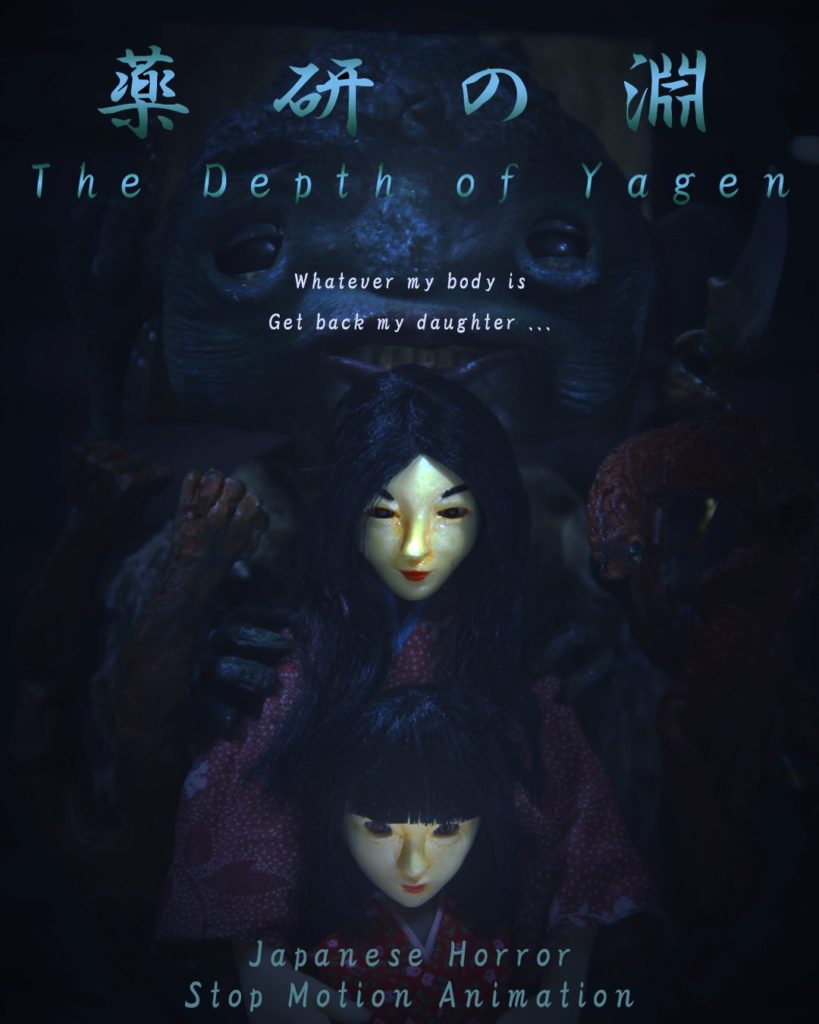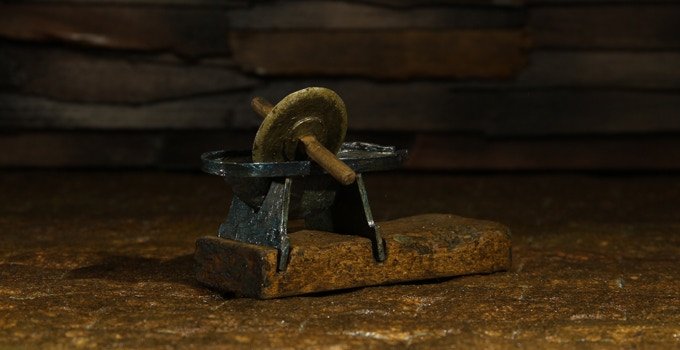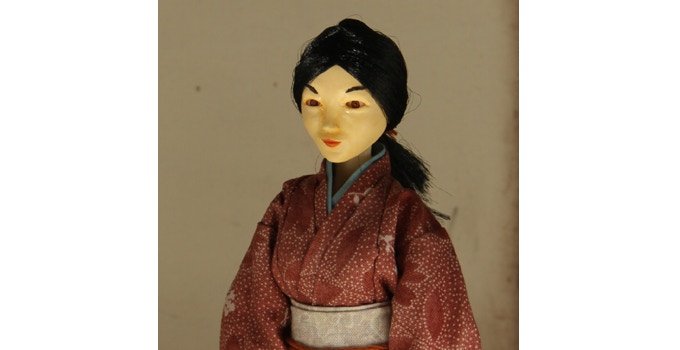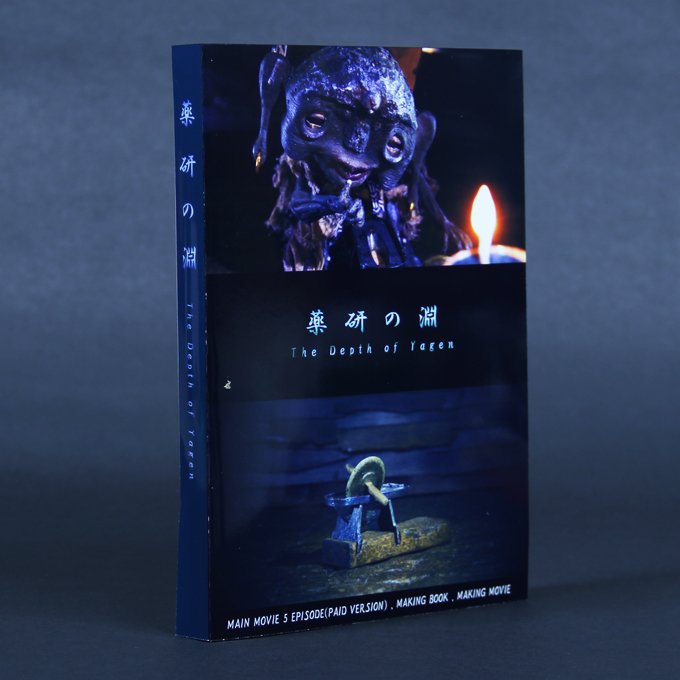An Interview with Shigeru Okada
Shigeru Okada (website) is a stop-motion animator who has been working for 15 years. He has worked on commercials for a host of companies such as Honda and McDonald’s, TV shows like Incredible Zorori and films. Most recently he was involved with the Netflix production of Rilakkuma and Kaoru which was recently launched on Netflix. In his spare time he makes animations which he uploads to his YouTube channel NARIOMARUDARKSIDE – a massive contrast to the laidback bear, since his independent projects tend to be Junji Ito-esque works where body-horror is expressed through claymation. This style of horror has been brought to his latest project, but with a switch in materials.
Okada has launched a Kickstarter for a totally original animation called The Depth of Yagen, a horror tale set in the past where a mother tries to save her daughter from human traffickers who are heading across a cursed mountain. As the mother pursues the villains, the curse of the mountain settles on her. This intriguing story is told in stop-motion and Okada plans to make five episodes. Further information can be found on the Kickstarter page and this news report. Okada kindly agreed to participate in an email interview through which I asked him more about himself and his project.

Your introduction says you started your career as a stop-motion animator at the age of 33. What did you do before then and why did you change careers?
大学の専攻が工学部だったので、卒業後はシステムエンジニアをしていました。ストップモーションアニメーションは大学にいた時から8mmフィルムを使って趣味で作っていて、大学を卒業後、自分のサイトを作って、一人で作った自主制作作品や独学で学んだ技術的なことを載せていました。このサイトがきっかけで、28歳の時に日本のストップモーションアニメーション業界で働いている人と出会い、休日にその人達の手伝いをしながら、ストップモーションアニメーションの技術を教えてもらいました。
初めて他の人から教わることが出来て、もっと本格的にやりたいと思うようになり、33歳で会社を辞めて、美術の手伝いやアニメーターのアシスタントを始めるようになりました。
I worked as a system engineer after graduating from my university’s faculty of engineering.
I was making stop-motion animations with 8mm film as a hobby during my college years and after I graduated, I launched my website and uploaded my own works and self-taught techniques. I met people who were engaged professionally in stop-motion animation through my website and started to help their works in my spare time and have learnt stop-motion animation techniques from them.
I found the pleasure of learning new techniques and became more serious about it, then quit my job as a system engineer and started to work as an apprentice for animators.
What were some of the challenges you encountered with the change?
自主制作と仕事はまったく違い、初めてのことばかりで、すべてが挑戦でした。
アニメーターという仕事をするための手順や技術のほとんどは、すべて撮影現場で仕事をやりながら覚えないといけませんでした。
仕事も多くなく、収入もシステムエンジニアをやっていたときの半分近くまで減り、余裕のない生活がしばらく続きましたが、周りの人に助けられてなんとかやっていくことが出来ました。
Everything was a challenge for me, because there was a massive difference in making animations as an amateur and as a professional. I had to learn most of the processes and technical methods to be an animator whilst working at the shooting sites. There were not many chances to work and my income became nearly half of the income I had earned from the system engineering job, so I had to force myself to live tightly. However, I managed to go through this tough time with support from people around me.
What is it about stop-motion that inspires you?
人形の関節の可動範囲が狭くて思うようなポーズが取れなかったり、動かしたくない箇所まで動いてしまったり、アニメートしている途中で人形が壊れてしまったり、とても大変な作業ですが、色々と解決策を探しながら問題を解決していくのが好きです。ストップモーションアニメーションでは、人形をアニメートして撮影をした後に、気になる箇所の動きを修正する、ということはほとんどできません。問題があったら最初から撮影し直さないといけないので、そういう意味で緊張感のある作業も好きです。
I sometimes struggle to manipulate a puppet to get it to make a particular pose because its joint mobility range is narrow, or I sometimes unwittingly make other parts of the body move or the puppet will break in the middle of animating. It is rather hard work, but I enjoy the process of solving problems. In stop-motion animation, it is hardly possible to correct the puppet’s movements in each scene after shooting the puppet’s animation. If there are problems, it is necessary to re-shoot the scene from the beginning, but in that way, I also enjoy working under a certain amount of pressure.

People are more familiar with 2D anime so can you describe a little the world of stop-motion?
人形や粘土や、身の回りにあるコップや鉛筆など、少し動かして1枚写真を撮り、また少し動かして写真を1枚撮る。という作業を繰り返し、その写真をパラパラ漫画のようにつなげて見ると、まるで生きているように動いているように見える。という手法です。作品に登場するセットや小道具や人形は全て手作りで、丸1日撮影しても数秒の映像しか撮れない場合もある、とても手間のかかる手法です。
You will move a puppet, clay, cups, pencils or anything around you, then take a picture and move them again and take a picture again. Repeat these actions and join the pictures together like a flip-book animation. Once joined it will look as if the puppets are alive. This is the method of stop-motion animation. Puppets, the set or the properties in the set are all handmade and even if we spend all day filming them we sometimes can only manage to capture a few seconds of one scene. It is very time consuming.
How do you balance production of The Depth of Yagen with other projects you have?
規模が大きく、多くの人が携わるようなプロジェクトに参加する時は、与えられた条件の中で、自分の役割を果たすことに集中します。遊び心を忘れずに楽しくやっていますが、時間的な余裕はあまり無いので、出来ることも限られているし、あまりリスクの高いことは出来ません。
The Depth of Yagenは個人制作なので、そういった大きなプロジェクトでは出来ないようなハイリスクなことでも面白いと思えば挑戦できます。表現方法も効果的だと思えば、誤解を恐れずに悪ノリと思われそうなことでも試すことが出来ます。そういう実験的な要素を含んだ作品にしたいと思っています。
規模が大きなプロジェクトで得た技術は自主制作に活用し、自主制作で成功した方法は規模が大きなプロジェクトに安心して使えます。どちらも自分にとっては有益で面白いです。
When I join a big project that lots of people are involved in, I focus on my role so I can achieve it under restricted conditions. I generally work with playfulness but most works should be done within a time frame and things I can work on are also limited, so I will not be allowed to try anything risky.
However, The Depth of Yagen is my own project, so I can take on a challenge by trying risky things, something which I’m not allowed to try on a big project. I will try different methods of expression if it is effective, I am not afraid of being misinterpreted or giving an impression of overdoing things. I hope my works contain experimental elements. The techniques I have learnt from some big projects will be useful to create my own works and vice versa, the methods I have successfully used on my own works can be safely used for big projects.
Where did your idea for the story of The Depth of Yagen come from?
海外のホラーは悪魔や魔女・殺人鬼といったものがよく出てきますが、ジャパニーズホラーは、人間(死者)の恨みや悲しみといった、どこにでもいる普通の人の強い思いが大きな役割を果たしていることが多いです。そういったものに、自分が好きな“THE THING”のようなクリーチャー系の要素を組み合わせたら、面白いものが出来ると思ったのが、今回の作品の始まりです。
It seems that the idea of horror in Western countries is something like devils, witches or ruthless killers, but in Japanese horror, excessive emotions such as a grudge or deep sorrow, something felt by ordinary people is the key element. I thought it would be interesting if I combine characteristics of Japanese horror with elements of some creatures like John Carpenter’s THE THING (one of my favourite films). This was my initial idea in the making of “Yagen”.
How long has it taken you to build the set and models?
予告編に使ったものは4ヶ月ほどで作りました。初めて挑戦する技術もあり、何度も失敗しながら作りました。撮影は1ヶ月です。
It took about four months to make the one I used for the trailer. There were some techniques I tried for the first time, so while I made it I experienced several failures. It took a month to shoot the trailer.
Your previous animations, Deformed Gecko and Saka Men involved clay models. Can you explain why you changed materials and could you describe your inspiration for the models/characters?
ホラーには質感が重要だということに気が付きました。体の一部が変形するようなシーンでは、自由に形を変えることが出来る素材で人形の体を作らないといけないので、今までの作品では粘土を使用しましたが、粘土は粘土にしか見えません。あと粘土は指で触った箇所が凹んでしまうので細かいディテールのものを作れません。コメディホラーのような作品なら、粘土も有効だと思いますが、自分はシリアスなホラーを作りたいので、もっとリアルな素材を使って質感を表現し、細かいディテールのものを使って不気味な世界観を表現したいと思いました。粘土も少しは使いますが、必要な時だけ使うことにします。
I have realised that texture is important for making horror animations. I used clay for my previous works but clay just looks like clay. For example, in some scenes where a part of the body needs to be altered, I had to use a material with a form that was flexible enough to change. And also, you cannot make something finely detailed with clay because it becomes dented when you touch it with your fingers. Clay might be useful for making something like comedy horror. I wanted to make a serious horror animation, so I used realistic materials, such as silicon used for special effect make-up or gel (for wet textures), to express its textures and materials with fine details to depict the eerie atmosphere. I occasionally use clay, but only when I really need to do.

Can you describe the work to create a stop-motion shot? Do you storyboard?
ストーリーボードは簡単なものを書きます。1秒撮るのに何時間もかかるので、実写映画のように、たくさんのカットを撮って必要なものだけを編集して使う、ということが出来ません。ストーリーボードを使って全体の流れを決めてから、必要なカットだけを撮影します。
撮影は、Dragonframeというストップモーションアニメーション用のソフトウェアを使います。一眼デジタルカメラをパソコンにUSBケーブルで接続して、パソコンのモニターに撮影した画像を表示しながら1枚ずつ写真を撮っていきます。Dragonframeを使えば、直前に撮影した画像とライブ映像を交互に表示して、人形がどれくらい動いたのかを確認したり、、その場で再生して動きをチェックすることも出来ます。
I roughly draw a storyboard. It doesn’t enable me to shoot many cuts and edit it and use some necessary cuts like a live-action film because it takes ages to shoot a scene of 1 second. I shoot only necessary cuts after deciding the whole flow of the animation using a storyboard.
I use a stop-motion animation software called Dragonframe. I connect a digital camera using a USB cable with a computer and take pictures, one at a time, whilst checking the picture on the computer screen.
Dragonframe allows me to compare a picture I have recorded which is displayed on the screen with a live picture of the puppet’s current position and check how much the puppets have moved or even rewind to check its movement at the same time.
You have complicated effects like fluid – blood, tears, vomit – and also lighting to consider. What is the most difficult thing to animate?
火や水や風といった自然現象をストップモーションアニメーションで表現するために多くのクリエイターが工夫しています。そういった作品を見てヒントを得たり、普段から使えそうな素材はチェックするようにしています。
でも一番難しいのは、人形の感情表現です。思ったことを全て口に出してしまうのが、一番早くてわかりやすいですが、台詞が多いストーリーは好きではないので、台詞は出来るだけ少なくして、人形の仕草で表現したいです。
Lots of creators struggle to create images of natural phenomena such as fire, water and wind in stop-motion animation. I try to get some tips from other people’s works or always check usable materials in everyday life.
However, the most difficult thing is to express each puppet’s emotion. It is probably easier to express feelings with words but I am not so keen on stories with lots of lines of dialogue, so I want to express each character’s emotion through a puppet’s gestures, not by speech.
What is the most rewarding part of getting a shot complete?
他の人に見てもらった時の観客のリアクションです。恐ろしい作品ですが、怖いものが好きな人に見てもらって楽しんでもらいたいです。
People’s reaction when they watch it. It is a scary animation but I would like people who like horror stories to watch and enjoy it.
What are the differences between this project and Rillakuma and Kaoru?
“Rillakuma and Kaoru”はとても大きなプロジェクトでアニメーターだけでも12人参加しています。自分はアニメーターの1人としてこのプロジェクトに参加し、Kaoruが住んでいるアパート内のシーンなどを担当しました。とても可愛らしいキャラクターが魅力的に描かれている手作り感が満載のお洒落な作品です。
“The Depth of Yagen”は個人の自主制作なので、脚本から人形やセットの制作や撮影まで、ほとんど自分一人で作業をしています。こちらはホラー作品なので、不気味で恐ろしい世界を描いています。
両者は作品の内容や制作体制が、両極端にあると言ってもいいぐらい、まったく正反対な作品です。同じストップモーションアニメーションという手法を使っていますが、これだけ多様な表現方法が出来るのがストップモーションアニメーションの面白いところだと思います。
Rillakuma and Kaoru is a rather big project and twelve animators are involved in it. I have participated in this project as one of the animators and was in charge of scenes inside the apartment where Kaoru lives. The loveable characters are beautifully depicted and it is a stylish work full of handmade feeling.
The Depth of Yagen is my self-produced work, so I do everything, from writing the script, creating puppets and film sets to shooting, by myself. This is a horror animation and it depicts an eerie and terrifying world. I could say that Rillakuma and Kaoru and The Depth of Yagen are as opposite as two poles in terms of its content and also in its production system. They both take the same method of stop-motion animation but there is such a wide range of style of expression in stop-motion animation. This is a fun part of stop–motion animation.
A recurring theme in your work is family and betrayal. Does this make for better horror stories?
ホラーの起点として、強い感情は理由付けとして必要なものだと思います。家族は一番身近にあって、一番強くて深い人間関係です。その関係が、嘘や裏切りといった行為で崩れる時に生まれる強く歪んだ感情は、ホラーにとって、とても旨味のある要素だと思います。今までの作品では単純に1家族についてのみ描いてきましたが、今回は、脇役それぞれの人生や思いも描いて少し複雑な話にしたいと思っています。
I think it is a core part for horror, to depict “excess emotion” as reasons for their actions. Family is the closest, strongest and deepest human relationship. But if this relationship is destroyed by lies or betrayals, it would bear a horribly twisted feeling among the family. This twisted feeling will create tasty elements for horror. I have been creating stories about families so far, but I want to make the next episode a bit more complicated by portraying life or the feeling of the side characters.
Which stop-motion animations and directors inspire you?
昔からよく見ていたのがRay Harryhausenのモンスター映画です。映画館で見られたのは「タイタンの戦い」だけですが、シンドバッドシリーズもビデオで何回も見ました。クリーチャー系が好きになったのも、その影響が大きいと思います。
自分が子供のころは、映画に登場するモンスターやロボットにストップモーションアニメーションが使われていて、スターウォーズやグレムリン、ロボコップといった作品を見るのも好きでした。ホラー以外にもそういったジャンルに挑戦してみたいです。
I like Ray Harryhausen’s monster films. The Clash of the Titans was the only one I could watch at a cinema, but I watched the movie series of Sindbad with videos several times. This is why I like animations about creatures.
When I was little, stop-motion animation was applied for monsters or robots in films. I liked watching “Star Wars”, “Gremlins” and “Robocop”. I would like to try making that kind of genre apart from horror.
What advice would you give to creators who want to do stop-motion?
日本では、ストップモーションアニメーションの仕事は少なく、制作会社も数社のみで、個人で制作している人も少なくありません。今まで、自分が持っているストップモーションアニメーションの知識や技術をワークショップやネットでシェアしてきましたが、海外からもリアクションがあって、日本だけではなく世界にも、小さな規模でストップモーションアニメーションを作っている人達はたくさんいることを知りました。
規模の大きなプロジェクトに参加すると、制作している現場で多くの知識と技術を得ることが出来ます。このプロジェクトでは、そういった技術を小規模なプロジェクトでも活用できるように工夫して、1つのストップモーションアニメーション作品が出来上がるまでの工程を、メイキングとして出来るだけ詳しく紹介することも大きな目的の1つです。
断片的に技術をシェアするよりも、作品を作る工程を最初から順を追って、具体的な例を見せながら紹介したほうが、わかりやすくて実際に活用しやすいと思います。
自分もクリエイターの一人ですが、同じような多くのクリエイターと繋がり、微力ながらサポートしていきたいと思っています。
There are not many job opportunities in stop-motion animation in Japan. There are only a few production companies, so most of the creators work independently. I had been sharing my knowledge and techniques on the internet and in workshops when I received some responses from abroad and realised that there are lots of people who make stop-motion animation on a small scale in foreign countries as well.
When you join a big project, you are able to gain knowledge and techniques from the production site. One of the main purposes of this project is to put these techniques (gained from some big projects) to practical use and to introduce the full details of the process of making a stop-motion animation. I think that it would be easier for people to understand and to practically utilise them if the whole process of a work were shown, with some practical examples, rather than bits of technique that are fragmentedly shared. As a creator myself, I would like to connect with other creators and try my best to support others.
Animator and author Shigeru Okada’s Kickstarter for his stop-motion indie horror film The Depth if Yagen is currently ongoing. The minimum Kickstarter pledge is £3 and that gives a person access to animation. Higher tiers include the animation, access to different versions of the “Making-of Book”, a DVD copy of the anime and even the chance to have a model of you created. To find out more, head to the Kickstarter page.



